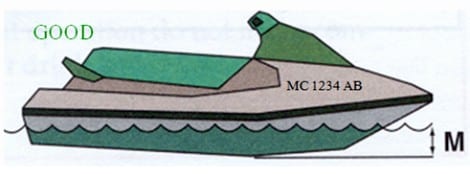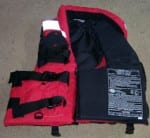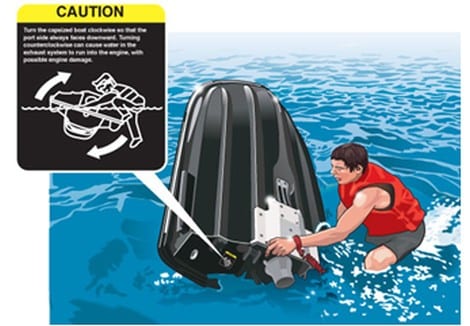 By Bob Currie, Vessel Examiner
By Bob Currie, Vessel Examiner
United States Coast Guard Auxiliary Flotilla 081-06-08
Flotilla 081-06-08 is based at Coast Guard Station Galveston. The Coast Guard Auxiliary is the uniformed civilian component of the US Coast Guard and supports the Coast Guard in nearly all mission areas. The Auxiliary was created by Congress in 1939. For more information, please visit www.cgaux.org. The Auxiliary’s vessel examiners perform safety checks on all types of recreational boats, including personal watercraft, also known as jet skis. The US Coast Guard Vessel Safety Check (VSC) has several requirements and recommendations specifically for personal watercraft (PWC) operators.
DISPLAY OF NUMBERS
PWC numbers are applied just as they are on any watercraft. Just be sure they are of contrasting color, 3 inches high, block letters (no fancy fonts), and properly spaced as in the diagram below.

LIFE JACKETS
PWC operators MUST wear a US Coast Guard approved life jacket. The Coast Guard recommends that life jackets be speed rated; that is, the life jacket should be designed to withstand the impact of hitting the  water at high speed. Impact life jackets are rated by the speed they will withstand and should be matched to the top speed of the PWC. Texas law prohibits the use of inflatable life jackets on PWC. Check the documentation inside the life jacket for its speed rating. This life jacket is rated for 100 mph. Any person towed by a PWC is considered to be an occupant of the PWC and is required to wear a life jacket.
water at high speed. Impact life jackets are rated by the speed they will withstand and should be matched to the top speed of the PWC. Texas law prohibits the use of inflatable life jackets on PWC. Check the documentation inside the life jacket for its speed rating. This life jacket is rated for 100 mph. Any person towed by a PWC is considered to be an occupant of the PWC and is required to wear a life jacket.
ENGINE CUT-OFF SWITCH LANYARD
PWC operators must wear a device that will kill the engine if the operator falls from the PWC. This device must be attached to the operator or the operator’s clothing when underway.

OPERATION OF YOUR PWC
All operational rules for regular motorboats also apply to PWC. In addition to those requirements, in Texas it is unlawful to (1) operate at night (sunset to sunrise); (2) operate within 50 feet of another PWC, motorboat, vessel, platform, person, object, or shore except at headway speed (headway speed is slow, idle speed, or speed only fast enough to maintain steerage) without creating a swell or wake; and (3) operate a PWC and jump the wake of another vessel recklessly or unnecessarily close.
NOTE: In Texas, children under 13 are specifically prohibited from operating a PWC unless accompanied on board by a person at least 18 years of age who can lawfully operate the PWC. To be able to lawfully operate a PWC, anyone born after September 1, 1983 must have completed a boater education course. Proof of completion must be carried with the boat operator.
VISUAL DISTRESS SIGNALS
Recreational boats less than 16 feet in length are not required to carry day signals. Night signals are not required for any PWC, regardless of length, because night time operation is not permitted. Bright clothing is recommended, as a PWC may not be readily seen by the operator of a much larger vessel.
FIRE EXTINGUISHER
 PWCs are required to carry USCG approved marine fire extinguishers. There are several types of fire extinguishers made just for PWC. Don’t forget about the Kidde brand fire extinguisher recall. Many of the recalled fire extinguishers were designed for PWC. The picture below is of one of the recalled PWC fire extinguishers.
PWCs are required to carry USCG approved marine fire extinguishers. There are several types of fire extinguishers made just for PWC. Don’t forget about the Kidde brand fire extinguisher recall. Many of the recalled fire extinguishers were designed for PWC. The picture below is of one of the recalled PWC fire extinguishers.
SOUND PRODUCING DEVICE
 As we know from previous discussions, ALL boats must have a sound producing device. PWC operators must have that sound producing device attached to their life jackets.
As we know from previous discussions, ALL boats must have a sound producing device. PWC operators must have that sound producing device attached to their life jackets.
BILGE REQUIREMENTS
 As with any inboard boat, the bilge must be free of debris and clean. Battery posts must be covered. There must be a backfire flame arrestor, but forced ventilation is not required.
As with any inboard boat, the bilge must be free of debris and clean. Battery posts must be covered. There must be a backfire flame arrestor, but forced ventilation is not required.
RIGHTING A CAPSIZED PWC
PWCs are designed to float when capsized. There is, however, a prescribed method for righting a capsized PWC. Most manufacturers have placed a decal at the rear or bottom of the craft that indicates the direction to roll your PWC to return it to an upright position. If no decal exists, check your owner’s manual or ask the dealer. With this information, you should be able to roll the PWC over and reboard with little trouble. If you roll it over the wrong way, you could damage your PWC.

For more information on boating safety, please visit the Official Website of the U.S. Coast Guard’s Boating Safety Division at www.uscgboating.org. Questions about the US Coast Guard Auxiliary or our free Vessel Safety Check program may be directed to me at [email protected]. I am available to perform free Vessel Safety Checks, and I will come to your location to perform them. SAFE BOATING!
[1-29-2018]

 Posted in
Posted in 























